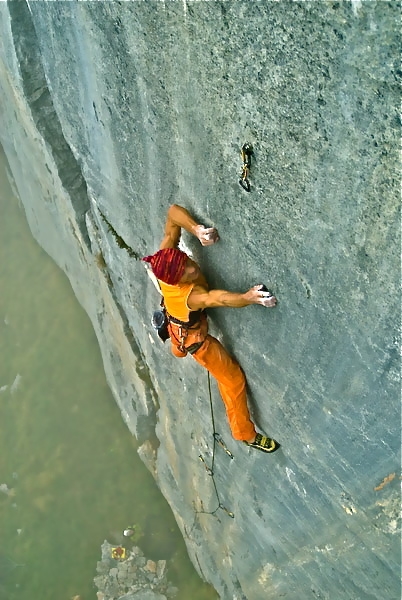Manolo: climbing and informed choices

 1 / 9
1 / 9 Marco Spataro
Marco Spataro
When I began climbing no one told me to use a helmet, I just put it on. It simply seemed like the sensible and right thing to do. It was something everyone had and was part of every climber's gear, like a rope, pegs and carabiners. Everyone though had knickerbockers, hobnailed boots and their strange convictions that the VI grade was man's extreme limit. Almost immediately afterwards I took my helmet off... I thought it was terribly unattractive and the only blows my head received were when I wore one. Just to make things clear: that was back in the day when you drove a motorbike without any protection whatsoever. Seat belts didn't exist and no skier, and certainly no cyclist, would even consider putting one on.
Together with my helmet I also took off the hobnailed boots and the full body harness. I didn't take off my blue jeans but instead I immediately breached the 8th grade with a pair of gym shoes. I continued to climb throughout the world and to be honest, since then I only ever put a helmet on when I worked as a mountain guide. I considered it to be a sign of respect, of education and responsibility towards others. I also have to say that I've never hit my head while climbing (even if I've fallen off thousands of times) and I've never been hit by even the tiniest of stones. Even though I've climbed on horrible rock. Yes, just one hit would have sufficed. Probably the truth is that I've been very lucky, but not wearing a helmet has always constantly forced me to be extremely vigilant. A bit like not having a self-locking device when belaying. These situations inevitably require constant and absolute attention.
Some rules don't necessarily need to become law and I hope that common sense prevails. I don't feel an outcast if I cycle without a helmet, just like if I ski without one. But I'm conscious of what I'm doing and the possible risk I'm taking and in some cases I adapt and wear one. As I explained previously, I belong to a generation that almost completely refused to use a helmet but then slowly developed a new education. I won't be shocked if children up to certain age are obliged to use helmets at indoor climbing walls, but it would be better if things weren't imposed in this manner. Parents or those who run the walls should somehow intervene in this sort of education. In the future these generations might find all this completely normal and always wear one.
When I climb at some fairly crowded crags I get really worried, all too often I see families with young children playing happily at the base. In some cases not even a helmet would suffice, but it's the least we can do.
Many crags appear totally safe. Solid rock and the easy approach can prove misleading. Now, moral responsibility apart, many crags are clean only to the top, while what lies above is completely unknown. Holds aren't always solid and even the most solid ones can suddenly break.
Offering good advice while continuing to provide a bad example isn't the most credible thing to do. I've certainly been extremely lucky to survive but it's exactly for this reason that I feel obliged to say so. There's a big difference between simply emulating someone, or deciding to do something consciously and with a critical eye. Without this learning, no seat belt and no helmet will ever protect you sufficiently. Also because nothing in life is that certain, perhaps not even death. The choice is yours!
by Manolo
| Expo.Planetmountain | |
| Expo Grivel | |
| Expo La Sportiva | |



 Copia link
Copia link







 See all photos
See all photos






















